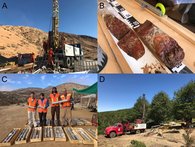

What processes take place beneath the Earth’s surface? Is there life? And how is soil developed from rock?
Within the framework of "DeepEarthShape", projects from the fields of geochemistry, microbiology, geophysics, geology, and biogeochemistry are involved in investigating the weathering zone in the subsurface of the Earth. In the geochemistry project, the chemical transformations of this weathering zone will be investigated using innovative geochemical and isotope methods.
This project is part of the DFG funded Priority Program (SPP 1803) „EarthShape: Earth Surface Shaping by Biota“.
A drilling campaign at all four primary "EarthShape" study sites provides a coherent and undisturbed insight in the Earth's surface. The preserved drill cores show a sequence from soil, strongly weathered saprolite to unweathered bedrock. Due to the different climatic conditions at the study sites it is possible to investigate weathering and weathering intensity regarding the amount of precipitation and degree of plant cover.
The great depth of weathering is surprising: the basis of weathering, the weathering front, was found at some study sites at 80 m depth!
The drill cores are examined using geochemical methods to detect changes in chemical and mineralogical composition. The elemental composition of the rock allows the calculation of weathering indicators showing the degree of weathering. Iron oxidation as the first weathering process is an indicator of the depth of weathering. Furthermore, petrophysical parameters such as density and porosity as well as the specific surface are also measured.
To determine the depth of water infiltration into the subsoil, we use meteoric cosmogenic 10Be and its ratio to stable 9Be which is a proxy for weathering. This completely new proxy provides information about the depth to which meteoric water is involved in the weathering process. Possible pathways for infiltration are tectonic fractures, fractures caused by weathering and rock porosity.
Furthermore, we will use the innovative combination of uranium decay series analyses (determining the weathering front advance rate) and in situ produced cosmogenic 10Be (determining surface denudation rates) to assess the balance between the production of weathered material at depth and the loss at the surface.
Time Frame
- 2018 - 2023
Funding
- DFG SPP 1803: „EarthShape: Earth Surface Shaping by Biota“
Publication
- Deep weathering in the semi-arid Coastal Cordillera, Chilehttps://doi.org/10.1038/s41598-021-90267-7
- Associated data publication: "Physical and geochemical data on a drill core from the semi-arid Coastal Cordillera, Chile, https://doi.org/10.5880/GFZ.3.3.2021.002



